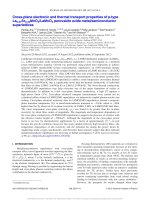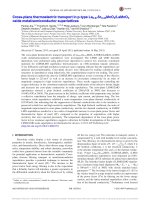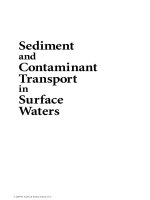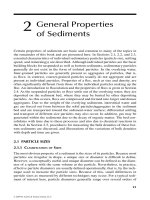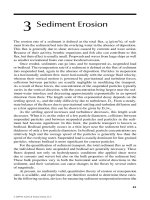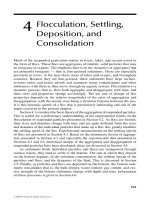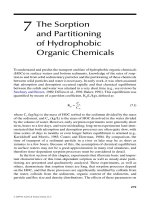cross plane thermoelectric transport in p type la0.67sr0.33mno3 lamno3 oxide metal semiconductor superlattices
Bạn đang xem bản rút gọn của tài liệu. Xem và tải ngay bản đầy đủ của tài liệu tại đây (2.45 MB, 8 trang )
Cross-plane thermoelectric transport in p-type La
0.67
Sr
0.33
MnO
3
/LaMnO
3
oxide metal/semiconductor superlattices
Pankaj Jha,
1,2
Timothy D. Sands,
1,2,3,a)
Philip Jackson,
4
Cory Bomberger,
5
Tela Favaloro,
4
Stephen Hodson,
6
Joshua Zide,
5
Xianfan Xu,
6
and Ali Shakouri
1,2
1
School of Electrical and Computer Engineering, Purdue University, West Lafayette, Indiana 47907, USA
2
Birck Nanotechnology Center, Purdue University, West Lafayette, Indiana 47907, USA
3
School of Materials Engineering, Purdue University, West Lafayette, Indiana 47907, USA
4
Electrical Engineering Department, University of California, Santa Cruz, California 95064, USA
5
Material Science and Engineering Department, University of Delaware, Newark, Delaware 19716, USA
6
School of Mechanical Engineering and Birck Nanotechnology Center, Purdue University, West Lafayette,
Indiana 47907, USA
(Received 17 January 2013; accepted 29 April 2013; published online 16 May 2013)
The cross-plane thermoelectric transport properties of La
0.67
Sr
0.33
MnO
3
(LSMO)/LaMnO
3
(LMO)
oxide metal/semiconductor superlattices were investigated. The LSMO and LMO thin-film
depositions were performed using pulsed laser deposition to achieve low resistivity constituent
materials for LSMO/LMO superlattice heterostructures on (100)-strontium titanate substrates.
X-ray diffraction and high-resolution reciprocal space mapping indicate that the superlattices are
epitaxial and pseudomorphic. Cross-plane devices were fabricated by etching cylindrical pillar
structures in superlattices using inductively, this coupled-plasma reactive-ion etching. The cross-
plane electrical conductivity data for LSMO/LMO superlattices reveal a lowering of the effective
barrier height to 223 meV as well as an increase in cross-plane conductivity by an order of
magnitude compared to high resistivity superlattices. These results suggest that controlling the
oxygen deficiency in the constituent materials enables modification of the effective barrier height
and increases the cross-plane conductivity in oxide superlattices. The cross-plane LSMO/LMO
superlattices showed a giant Seebeck coefficient of 2560 lV/K at 300 K that increases to
16 640 lV/K at 360 K. The giant increase in the Seebeck coefficient with temperature may include
a collective contribution from the interplay of charge, spin current, and phonon drag. The low
resistance oxide superlattices exhibited a room temperature cross-plane thermal conductivity of
0.92 W/m K, this indicating that the suppression of thermal conductivities due to the interfaces is
preserved in both low and high resistivity superlattices. The high Seebeck coefficient, the order of
magnitude improvement in cross-plane conductivity, and the low thermal conductivity in LSMO/
LMO superlattices resulted in a two order of magnitude increase in cross-plane power factor and
thermoelectric figure of merit (ZT), compared to the properties of superlattices with higher
resistivity that were reported previously. The temperature dependence of the cross-plane power
factor in low resistance superlattices suggests a direction for further investigations of the potential
LSMO/LMO oxide superlattices for thermoelectric devices.
V
C
2013 AIP Publishing LLC.
[ />I. INTRODUCTION
Perovskite oxides display a rich variety of electronic
properties as metals, ferroelectrics, ferromagnetics, multifer-
roics, and thermoelectrics. Due to their diverse range of prop-
erties, temperature stability, and robust chemistry, perovskite
oxides have garnered interest from the scientific community
for potential application as thermoelectric materials. Cross-
plane electron filtering transport in metal/semiconductor
superlattices provides a potential technique to increase the
thermoelectric figure of merit (ZT).
1
The increase in the
power factor from energy filtering is due to the expectation
that a Schottky barrier will introduce a greater asymmetry in
the differential conductivity about the Fermi level by cutting
off the low energy tail. The reduction in transport carriers is
compensated by a well with metallic level carrier concentra-
tion. The efficiency of a thermoelectric device is given by the
dimensionless figure of merit, ZT; ZT ¼
S
2
r
ðj
e
þ j
l
Þ
T, where S is
the Seebeck coefficient, r is the electrical conductivity, T
is the absolute temperature (K), and j is the thermal conduc-
tivity. P-type La
0.67
Sr
0.33
MnO
3
(LSMO)/LaMnO
3
(LMO)
metal/semiconductor superlattices were deposited on (100)-
strontium titanate (STO) substrates by pulsed laser deposition
(PLD). The Schottky barrier height of LSMO/LMO superlat-
tices calculated using band alignment (A
B
¼ E
g
þ v
s
À A
m
)
is 300 meV $ 11 kT at 300 K with closely matched lattice
parameters.
2,3
The lowering of the barrier height of 11 kT in
the valence band for p-type material enables an improvement
of the power factor (S
2
r) by filtering out the lower energy
carriers, and the lattice-matched superlattices allow a reduc-
tion of the thermal conductivity.
4
Preliminary work focused
a)
Author to whom correspondence should be addressed. Electronic mail:
0021-8979/2013/113(19)/193702/8/$30.00
V
C
2013 AIP Publishing LLC113, 193702-1
JOURNAL OF APPLIED PHYSICS 113, 193702 (2013)
Downloaded 16 May 2013 to 128.46.221.60. This article is copyrighted as indicated in the abstract. Reuse of AIP content is subject to the terms at: />on cross-plane transport of high resistivity p-type LSMO/
LMO superlattices. The high resistivity helped mitigate the
effects of electrical and thermal parasitics in cross-plane
transport measurements, thereby allowing interpretation of
measurements of thermionic transport, barrier height, and lat-
tice thermal conductivity. These high resistivity superlattices
used for the prior investigation were grown at a low oxygen
partial pressure of 50 6 2 mTorr. The low oxygen partial
pressure resulted in a film with in-plane resistivities more
than two orders of magnitude higher than the resistivities
obtained at higher oxygen partial pressure during growth.
5
LSMO/LMO superlattices exhibited a substantially lower
room temperature thermal conductivity (0.89 W/m-K) than
those of the constituent materials, which indicates that cross-
plane phonon scattering reduces the lattice contribution to the
thermal conductivity. The cross-plane conductivity of the
superlattice structure extracted from I-V-T measurements
of etched pillars suggests a contribution from thermionic
behavior, and the extracted effective barrier height of
300 6 15 meV is consistent with the theoretically expected
LSMO/LMO Schottky barrier height (A
B
)of$300 meV
at 300 K. The measured Seebeck coefficient was 1520
6 53 lV/K. In spite of the suppressed thermal conductivity,
the ZT achieved was low due to a low power factor (S
2
r),
which was a consequence of the high resistivities of the con-
stituent materials combined with a high barrier height relative
to kT at room temperature.
6
The present work focused on increasing the cross-plane
conductivity in superlattices by using low resistivity constit-
uent materials and by lowering the effective barrier height .
In this paper, the deposited low resistivity heterostructures
and their cross-plane thermoelectric transport properties are
discussed in light of prior measurements of hig h-resistivity
superlattices. The potential for tuning perovskite oxide
superlattices for applications as thermoelectric materials at
moderate temperatures is also evaluated.
II. EXPERIMENT
ThegrowthofLSMOandLMOthinfilmson(100)-
oriented cubic STO substrates was achieved using PLD.
The growth conditions used were 248 nm KrF excimer laser
(pulse width of 25 ns), laser fluence of 1.3 J/cm
2
,pulsefre-
quency of 5 Hz, and temperature maintained at 750
C
measured using an infrared pyrometer (STO emissivity of
0.8). The target was mechanically polished prior to each
growth to achieve a uniform film. Epitaxial high resistivity
thin films of LSMO and LMO on STO were also deposited
by PLD using a background O
2
pressure of 52 mTorr to
compare their post-growth annealing behavior with that of a
sample grown at a higher oxygen partial pressure of
280 mTorr. Post-growth annealing in oxygen did not appre-
ciably affect the conductivity of the sample grown at
52 mTorr (Fig. 1). Hence, the control of oxygen stoichiome-
try was focused on optimizing the oxygen partial pressure
during growth to achieve low resistivity thin films and
superlattices.
Optimization of the resistivity of the LSMO and LMO
thin films was achieved with oxygen partial pressures in the
range of 200–300 mTorr. The films grown at 210 6 3 mTorr
resulted in the lowest resistivity (Fig. 2). LSM O and LMO
films were deposited under conditions that yielded a 100Â
increase in electrical conductivity compared to thin films at
52 mTorr, approaching the conductivity of a good thermo-
electric material ($1000/X cm). The oxygen partial pressure
effect on conductivity can be related to double exchange
interactions between Mn
3þ
and Mn
4þ
ions. The parent com-
pound LaMnO
3
(Mn
3þ
,t
3
2g
e
1
g
), with ion vacancies of La
3þ
,
Mn
3þ
, and O
2À
, allows doping on all lattice sites. The parent
compound exhibits a ferromagnetic and semicon ducting
phase and conducts by cation transitions.
7,8
The cation
vacancies are responsible for causing mixed manganese
Mn
3þ
and Mn
4þ
ions for charge neutrality.
9
LaMnO
3
with
Sr
2þ
doping (La
0.67
Sr
0.33
MnO
3
) creates a change of Mn
3þ
to
Mn
4þ
with no e
g
electron (t
3
2g
e
0
g
). The hole hopping from a
Mn
4þ
ion to a Mn
3þ
ion is possible only if the localized
spins on adjacent Mn ions are parallel. This interaction
between adjacent Mn ions is dominated by the double-
exchange mechanism through an oxygen ion and is responsi-
ble for metallic behavior in LSMO.
10
These Mn
4þ
and Mn
3þ
ion concentrations are susceptible to any change in oxygen
stoichiometry, which is controlled by the oxygen partial
FIG. 1. Measured room temperature conductivity of LSMO and LMO thin
films after two-stage annealing process: Stage-I (750
C, 300 mTorr, 15 h
PLD), and Stage-II (900
C, atmospheric O
2
pressure, tube furnace).
FIG. 2. Measured room temperature conductivity of the LSMO and LMO
thin films grown at higher oxygen partial pressure. LSMO and LMO films
were deposited under 210 mTorr that yielded a 100Â increase in electrical
conductivity compared to high resistivity constituent material thin films
grown at 52 mTorr oxygen partial pressure.
193702-2 Jha et al. J. Appl. Phys. 113, 193702 (2013)
Downloaded 16 May 2013 to 128.46.221.60. This article is copyrighted as indicated in the abstract. Reuse of AIP content is subject to the terms at: />pressure. A higher oxygen partial pressure increases the
Mn
4þ
ion concentration, which results in higher conductivity
and higher mobility. A lower oxygen partial pressure creates
oxygen vacancies, which accommodate in the vicinity of
Mn
3þ
ions compared to Mn
4þ
ions. For every oxygen
vacancy, one Mn
4þ
is replaced by two Mn
3þ
ions with a sig-
nificant increase in the c-axis lattice parameter in LMO,
resulting in high resistivity films.
11–13
The LSMO and LMO
samples grown at higher oxygen partial pressures have a
high concentration of carriers, resulting in low resistivity
films with better mobility.
LSMO and LMO thin-film structural analyses were per-
formed using X-ray diffraction (XRD). XRD 2-theta-omega
(2h-x) shows h001i-textured LSMO films on STO substrates
without any additional impurity phases. The narrow full-
width-at-half-maximum (FWHM) intensity of the rocking
curve (0.012
) suggests high crystalline quality. Highly
aligned grains and in-plane epitaxy were confirmed by asym-
metric 110 phi scans of LSMO on STO, which showed that
all four 90
-separated film peaks were well-aligned with the
substrate peaks. LMO 2h-x analyses of the sample grown at
a higher oxygen pressure in the range of 200–300 mTorr
showed that the LMO peak at 3.89 A
˚
overlaps with the STO
substrate peak. In contrast, for LMO films grown at a low
oxygen partial pressure of 52 mTorr, the c-axis lattice
parameter increases from 3.89 A
˚
to 3.94 A
˚
(Fig. 3). The over-
lapping of the LMO film peak with the STO peak at higher
oxygen partial pressure is consistent with prior observa-
tions.
12
110 asymmetric phi scans confirmed highly aligned
grains and in-plane epitaxy. Symmetrical 002 reciprocal
space mapping (RSM) showed the LMO peak intensity
spread overlaps with the high intensity STO peak, confirm-
ing epitaxy.
The low resistivity LSMO/LMO superlattices were
grown at 210 6 3 mTorr oxygen partial pressure, maintain-
ing all other growth parameters the same (Fig. 4). The 2h-x
analyses showed that the 002 film peak aligned with the STO
002 peak, confirming epitaxy (Fig. 5(a)). In-p lane epitaxy
and aligned grain were confirmed by asymmetric 110 phi
FIG. 3. XRD 2-theta-omega scan of an LMO on a STO (100) substrate
confirming c-axis epitaxial behavior. The LMO grown at 52 mTorr partial
oxygen pressure shows a distinguishing peak with a ¼ 3.94 A
˚
whereas the
LMO grown at 210 mTorr peak overlaps with the STO peak.
FIG. 4. Schematic of metallic LSMO (8 nm)/semiconducting LMO (8 nm)
superlattice (LSMO/LMO)
51
structure grown by PLD.
FIG. 5. (a) XRD 2-theta-omega scan of an LSMO/LMO superlattice on a
STO (100) substrate confirming c-axis epitaxial behavior with LSMO
FWHM (0.187
) and (b) 110 RSM of a micron-thick LSMO/LMO superlat-
tice confirming the LMO peak overlapping with STO peak, and pseudomor-
phic growth of epitaxial LSMO and LMO superlattice films.
193702-3 Jha et al. J. Appl. Phys. 113, 193702 (2013)
Downloaded 16 May 2013 to 128.46.221.60. This article is copyrighted as indicated in the abstract. Reuse of AIP content is subject to the terms at: />scans of superlattices, which showed that all four 90
-
separated film peaks of LSMO and LMO were well-aligned
with the STO substrate peaks. A 110 reciprocal space map
from an oxide superlattice was analyzed to understand the
degree of relaxation and strain in the superlattice layers
(Fig. 5(b)). The degree of spread around the STO peak con-
firms that the LMO peak overlaps with the STO peak; this
overlap along with the intense LSMO peak confirms the
pseudomorphic nature of the superlattice on STO substrates.
III. RESULTS AND DISCUSSION
A. LSMO and LMO thin films
The in-plane electrical transport properties of epitaxial
LSMO grown at 210 mTorr were extracted from measure-
ments of resistivity, Seebeck coefficient, and carrier
concentration. Hall measurements of a 200 nm thick epitax-
ial LSMO film on ST O showed a room temperature
resistivity of 1.52 Â 10
À3
X cm, a hole carrier concentration
of 1.12 Â 10
21
cm
À3
, and mobility of 3.67 cm
2
/Vs, in the
range of typical oxide thermoelectric materials. Four-probe
temperature dependent resistivity (TDR) measurements of
LSMO, with (H ¼ 0.2 T) and without (H ¼ 0 T) a magnetic
field, showed a 100Â increase in electrical c onductivity
compared to high resistivity LSMO thin films grown at
52 mTorr (Fig. 6(a)), approximately in the range of a good
thermoelectric material ($1000/X cm). The increase in the
conductivity of LSMO is due to a higher carrier concentra-
tion with polaronic hopping conduction, with an extracted
thermal activation energy (E
A
)of97.06 5meV.
14,15
The
in-plane temperature dependent Seebeck measurement of
LSMO showed a Seebeck coefficient with a magnitude less
than 15 lV/K over the entire temperature range, which is
consistent with metallic behavior (Fig. 7(a)).
16
Similarly, an epitaxial 200 nm thin film of LMO was char-
acterized using the Hall effect me a surement t echnique, which
provided a room temperature resistivity of 2.79 Â 10
À1
X cm,
and a hole carrier conc entration of 1 .15 Â10
19
cm
À3
with a
hole mobility of 1.94 cm
2
/Vs. Temperature dependent four-
probe resistivity measurement of LMO with and without mag-
netic field also sh owed a 100Â incre ase in the conductivity,
with a thermal activation energy (E
A
)of93.06 5meV
(Fig. 6(b)). The in -plane temperature dependent Seebeck mea-
surement with a room temperature Seebeck coefficient of
60 6 3 lV/K confirmed that the LMO films were p-type
(Fig. 7(b)).
The temperature dependent resistivity measurement at a
magnetic field of 0.2 T of LSMO thin films grown at a higher
oxygen pressure (210 mTorr) shows low magnetoresistance
($6%) and a LMO thin-film MR ratio of $40%. The LSMO
sample grown at 52 mTorr showed a MR ratio of $16% and
the LMO MR ratio was $52%. This high MR in the sample
grown at low oxygen pressure is attributed to a disordered
FIG. 6. Temperature-dependent in-plane resistivity with and without a mag-
netic field applied in a direction normal to the film surface for (a) LSMO,
and (b) LMO.
FIG. 7. (a) In-plane Seebeck measurement of LSMO showing that the
Seebeck coefficient is consistent with metallic behavior with a magnitude of
less than 15lV/K and (b) in-plane Seebeck measurement of LMO validating
p-type behavior with a room temperature Seebeck coefficient of 60 6 3 lV/K.
193702-4 Jha et al. J. Appl. Phys. 113, 193702 (2013)
Downloaded 16 May 2013 to 128.46.221.60. This article is copyrighted as indicated in the abstract. Reuse of AIP content is subject to the terms at: />spin state, in contrast to films grown at high oxygen pressure,
which change to an ordered state with applied magnetic
field.
11,17
B. Cross-plane thermoelectric transport
Thermal conductivity of LSMO/LMO superlattices was
measured using a photo-acoustic (PA) technique.
18,19
The
high resistivity superlattices grown at 52 mTorr showed a
cross-plane room temperature thermal conductivity of
0.89 W/m-K. Phonon scattering at interfaces showed a reduc-
tion in the lattice contribution to the thermal conductivity.
6
The low resistivity LSMO/LMO superlattices grown at 210
mTorr exhibited a room temperature thermal conductivity of
0.92 6 0.12 W/m-K. The cross-plane thermal conductivity in
the temperature range of 300 K–380 K is shown in Figure 8.
The cross-plane thermal conductivity indicates that the sup-
pression of thermal conductivity due to the interfaces is pre-
served. The estimated cro ss-plane electronic contribution
(j
e
) using the Wiedemann-Franz law (j
e
¼ L
o
rT) was found
to be negligible in both high and low resistivity LSMO/LMO
superlattices. The measured temperature dependent thermal
conductivity is comparably lower than that of bulk oxides
and composite materials and comparable to heavy metallic
alloys (0.5–2 W/m-K).
20
The cross-plane electrical transport (power factor) mea-
surement required etching of cylindrical pillar structures
(1.1 lm height and 300 lm diameter) on the superlattices to
reach the bottom buffer layer (Fig. 9(a)). The cylindrical pil-
lar device structures were fabricated using AZ-9260 resist as
an etching mask for inductively coupled plasma reactive ion
etching (ICP-RIE) (Fig. 9(b)). The etching recipe used was
40:10 sccm of Cl
2
:Ar, a chamber pressure of 0.7 Pa, a RF
forward power of 800 W, and a capacitive bias of 350 W.
The metallization used for top and bottom contacts consisted
of three layers, Ti (8 nm)/Pt (125 nm)/Au (500 nm), to
achieve good ohmic contact with LSMO/LMO superlattices.
In-plane temperature-dependent resistivity measurements
were performed on the LSMO/LMO superlattices (Fig. 10),
which showed a thermal activation energy (E
A
)of
114 6 6 meV (Fig. 11). Temperature dependent I-V measure-
ments in the temperature range of 100–600 K were
performed on the cross-plane cylindrical devices. The
extracted temperature dependent conductivity showed an
order of magnitude increase in the cross-plane conductivity,
compared to high resistivity superlattices (Fig. 12). The
effective barrier height of 223 6 11 meV was extracted from
the cross-plane temperature dependent electrical conductiv-
ity data for LSMO/LMO superlattices (Fig. 13). The fact that
the effective cross-plane barrier is higher than that measured
for in-plane transport suggests that the temperature depend-
ence of cross-plane conductivity was dominated by interface
effects such as thermionic emission over interfacial barriers.
FIG. 8. Temperature-dependent cross-plane thermal conductivity of p-type
LSMO/LMO superlattice.
FIG. 9. (a) Field emission scanning electron microscope top view images of
anisotropically etched LSMO/LMO superlattices by ICP-RIE, and (b) the
schematic of side view of the final structure of LSMO/LMO superlattices for
I-V cross-plane measurement.
FIG. 10. Temperature-dependent in-plane resistivity of p-type LSMO/LMO
superlattice.
193702-5 Jha et al. J. Appl. Phys. 113, 193702 (2013)
Downloaded 16 May 2013 to 128.46.221.60. This article is copyrighted as indicated in the abstract. Reuse of AIP content is subject to the terms at: />The modification of the room temperature barrier (A
B
)
height by varying the doping levels (i.e., by growing at high
oxygen pressure) of the constituent materials in the superlat-
tices enables the lowering of the effective barrier by approxi-
mately 75 meV.
Cross-plane Seebeck coefficient measurements in the
temperature range of 300 K–360 K were performed using a
thermal imaging technique.
21
The measured room tempera-
ture cross-plane Seebeck coefficient for low resistivity super-
lattices was 2560 6 130 lV/K. The Seebeck coefficient of the
low resistivity sample increased with temperature to
8520 6 430 lV/K (320 K), 11 160 6 560 lV/K (340 K), and
16 6406 830lV/K (360 K) (Fig. 14). A “colossal” Seebeck
coefficient of $À45 000lV/K was reported by Bentien et al.
in a strongly correlated semiconductor material (FeSb
2
) with
a very large thermal conductivity, which yielded a low ther-
moelectric figure of merit of 0.005
.
22–24
Later, Song et al.
reported a “giant” Seebeck coefficient of $À20 000 lV/K in
nano-MnO
2
powder sample around room temperature with a
very high electrical resistance of 30 kX.
25
The measured
Seebeck coefficient of low resistivity LSMO/LMO superlatti-
ces is higher, the cross-plane conductivity is higher, and the
effective barrier is lower (by $75 meV) in comparison with
prior results with high resistivity superlattices. Although a
lower barrier height (expressed as a ratio with k
B
T) may yield
a power factor that is closer to the optimal value in the therm-
ionic model,
26
LSMO/LMO materials exhibit additional
physics that may be at least as important in determining the
cross-plane transport properties. The LSMO/LMO superlat-
tice constituent materials exhibit spintronic properties where
charges and spin current are intertwined and can generate
a spin-Seebeck effect.
27,28
Therefore, the observed giant
increase in the Seebeck coefficient with temperature in
LSMO/LMO superlattices may be an indication of possible
collective contribution from interplay of charge and spin
transport in superlattices.
29–31
It may be concluded that the
temperature gradient across the ferromagnetic conductor
(LSMO) generates spin current. These spin currents may be
injected into the ferromagnetic semiconductor (LMO) due to
lowering of the effective barrier height, which leads to a giant
spin-Seebeck effect. This phenomenon of generation of
charge, spin current, and phonon-magnon (spin waves) cou-
pling is referred to as the spin-Seebeck effect or spin calori-
tronic effect.
32–34
The entire contribution in the LSMO/LMO
FIG. 11. The in-plane LSMO/LMO superlattice electrical conductivity plot
fitted to extract the effective thermal activation energy of 114 6 6 meV.
FIG. 12. Extracted cross-plane resistivity of the p-type LSMO/LMO super-
lattice using temperature dependent I-V measurement.
FIG. 13. Arrhenius plot of cross-plane LSMO/LMO superlattice electrical
conductivity. The fitting extracted an effective barrier height of
223 6 11 meV.
FIG. 14. The LSMO/LMO superlattice cross-plane Seebeck coefficient mea-
surement using thermal imaging technique showed a giant Seebeck coeffi-
cient of 2560 6 130lV/K at 300 K, which increased to 16 640 6 830 lV/K
at 360 K.
193702-6 Jha et al. J. Appl. Phys. 113, 193702 (2013)
Downloaded 16 May 2013 to 128.46.221.60. This article is copyrighted as indicated in the abstract. Reuse of AIP content is subject to the terms at: />superlattice thermal conductivity is from the lattice contribu-
tion. Therefore, it may be possible that phonon-drag effects
also contributed to the huge enhancement of the Seebeck
coefficient in superlattices.
35
The giant contribution of
spin-Seebeck, the large temperature dependence, and the low
thermal conductivity in LSMO/LMO superlattices may offer
opportunities to realize spin-dependent thermoelectric devi-
ces or magnetic thermoelectric devices where the collective
effect of charge, spin, and heat transport can be utilized to
increase the efficiency of thermoelectric devices.
36,37
The extracted cross-plane temperature dependent power
factor (S
2
r) of low resistivity LSMO/LMO superlattices
(Fig. 15) increased by two orders of magnitude compared to
high resistivity 52 mTorr superlattices and reached
$0.95 lW/cm K
2
. Combining the cross-plane power factor
and thermal conductivity of the LSMO/LMO superlattices
yielded a thermoelectric figure of merit (ZT)of$0.037 at
360 K (Fig. 16). Although this value is far from the range of
useful values for power conversion (1.0 or greater), the
increase of ZT by two orders of magnitude over that achieved
for superlattices grown at 52 mTorr suggests that there is fur-
ther room for improvement.
IV. CONCLUSIONS
The increase in the power factor and ZT by two orders
of magnitude for LSMO/LMO superlattices grown under
conditions that yield constituent phases with low in-plane
resistivities suggests that further modifications of these mate-
rials may lead to significant enhancements in thermoelectric
transport properties. The results are consistent with on-going
in-plane thermoelectric studies in perovskite oxide materi-
als.
38,39
The current results suggest that the approach of
using oxide superlattices may be a viable route toward a
potential material for thermoelectric devices as a result of
the low cross-plane thermal conductivity and the unusual
physics that leads to the giant value of the Seebeck coeffi-
cient; however, much more work needs to be done to firmly
establish oxide superlattices as a prospect for devices that
operate at moderate and high temperature. The possibility to
further increase cross-plane conductivity via doping/substitu-
tion of atoms, lowering of the effective barrier, and post-
growth oxygen annealing of low resistivity superlattices may
improve the thermoelectric figure of merit. The results of
further studies should also elucidate the complex physics of
transport in these artificial materials.
ACKNOWLEDGMENTS
The authors would like to acknowledge support by the
DARPA Nanostructured Materials fo r Power program.
1
A. Shakouri and J. E. Bowers, “Heterostructure integrated thermionic
coolers,” Appl. Phys. Lett. 71, 9 (1997).
2
A. Urushibara, Y. Moritomo, T. Arima, A. Asamitsu, G. Kido, and Y.
Tokura, “Insulator-metal transition and giant magnetoresistance in
La
1Àx
Sr
x
MnO
3
,” Phys. Rev. B 51(20), 14103 (1995).
3
T. Kida, G. Q. Guan, and A. Yoshida, “LaMnO
3
/CdS nanocomposite: A
new photocatalyst for hydrogen production from water under visible light
irradiation,” Chem. Phys. Lett. 371, 563 (2003).
4
R. Venkatasubramanian, “Lattice thermal conductivity reduction and
phonon localization-like behavior in superlattice structures,” Phys. Rev. B
61(4), 3091 (2000).
5
M. Huijben, L. W. Martin, Y. H. Chu, M. B. Holcomb, P. Yu, G. Rijnders,
D. H. A. Blank, and R. Ramesh, “Critical thickness and orbital ordering in
ultrathin La
0.7
Sr
0.3
MnO
3
films,” Phys. Rev. B 78, 094413 (2008).
6
P. Jha, T. Sands, L. Cassels, P. Jackson, T. Favaloro, B. Kirk, X. Xu,
J. Zide, and A. Shakouri, “Cross-plane electronic and thermal transport
properties of p-type La
0.67
Sr
0.33
MnO
3
/LaMnO
3
perovskite oxide metal/
semiconductor superlattices,” J. Appl. Phys. 112, 063714 (2012).
7
C. Aruta, M. Angeloni, G. Balestrino, N. G. Boggio, P. G. Medaglia,
A. Tebano, B. Davidson, M. Baldini, D. Di Castro, P. Postorino, P. Dore,
A. Sidorenko, G. Allodi, and R. De Renzi, “Preparation and characteriza-
tion of LaMnO
3
thin films grown by pulsed laser deposition,” J. Appl.
Phys. 100(2), 023910 (2006).
8
A. Gupta, T. McGuire, P. Duncombe, M. Rupp, J. Sun, W. Gallagher, and
G. Xiao, “Growth and giant magnetoresistance properties of La deficient
La
x
MnO
3Àd
(0.67 x 1) films,” Appl. Phys. Lett. 67, 3494 (1995).
9
W. S. Choi, Z. Marton, S. Y. Jang, S. J. Moon, B. C. Jeon, J. H. Shin, S. S.
A. Seo, T. W. Noh, K. Myung-Whun, H. N. Lee, and Y. S. Lee, “Effects
of oxygen-reducing atmosphere annealing on LaMnO
3
epitaxial thin
films,” J. Phys. D: Appl. Phys. 42(16), 165401 (2009).
10
C. Zener, “Interaction between the d-shells in the transition metals. 2.
Ferromagnetic compounds of manganese with perovskite structure,” Phys.
Rev. 82(3), 403 (1951).
11
J. Dho, N. Hur, I. Kim, and Y. Park, “Oxygen pressure and thickness
dependent lattice strain in La
0.7
Sr
0.3
MnO
3
films,” J. Appl. Phys. 94, 7670
(2003).
12
P. Orgiani, C. Aruta, R. Ciancio, A. Galdi, and L. Maritato, “Enhanced
transport properties in La
x
MnO
3Àd
thin films epitaxially grown on SrTiO
3
FIG. 15. The extracted cross-plane power factor (S
2
r) of the low resistivity
p-type LSMO/LMO superlattice. The power factor increased by two orders
of magnitude compared to high resistivity superlattices grown at 52 mTorr.
FIG. 16. The extracted cross-plane thermoelectric figure-of-merit (ZT)of
p-type LSMO/LMO superlattices. The cross-plane ZT increased by two orders
of magnitude compared to high resistivity superlattices grown at 52 mTorr.
193702-7 Jha et al. J. Appl. Phys. 113, 193702 (2013)
Downloaded 16 May 2013 to 128.46.221.60. This article is copyrighted as indicated in the abstract. Reuse of AIP content is subject to the terms at: />substrates: The profound impact of the oxygen content,” Appl. Phys. Lett.
95, 013510 (2009).
13
Y. S. Du, B. Wang, T. Li, D. B. Yu, and H. Yan, “Effects of annealing pro-
cedures on the structural and magnetic properties of epitaxial
La
0.7
Sr
0.3
MnO
3
films,” J. Magn. Magn. Mater. 297, 88 (2006).
14
J. Millis, P. B. Littlewood, and B. I. Shraiman, “Double exchange alone
does not explain the resistivity of La
1Àx
Sr
x
MnO
3
,” Phys. Rev. Lett. 74,
5144 (1995).
15
M. Ziese and C. Srinitiwarawong, “Polaronic effects on the resistivity of
manganite thin films,” Phys. Rev. B 58, 11519 (1998).
16
T. M. Palstra, A. P. Ramirez, S. W. Cheong, B. R. Zegarski, P. Schiffer,
and J. Zaanen, “Transport mechanisms in doped LaMnO
3
: Evidence for
polaron formation,” Phys. Rev. B 56, 5104 (1997).
17
P. Murugavel, P. Padhan, and W. Prellier, “Effect of oxygen pressure on
the interface related magnetic and transport properties of La
0.7
Sr
0.3
MnO
3
/
BaTiO
3
superlattices,” J. Phys.: Condens. Matter 18, 3377 (2006).
18
H. P. Hu, X. W. Wang, and X. F. Xu, “Generalized theory of the photoa-
coustic effect in a multilayer material,” J. Appl. Phys. 86(7), 3953 (1999).
19
X. W. Wang, H. P. Hu, and X. F. Xu, “Photo-acoustic measurement of
thermal conductivity of thin films and bulk materials,” ASME Trans. J.
Heat Transfer 123(1), 138 (2001).
20
H. Ohta, S. Kim, Y. Mune, T. Mizoguchi, K. Nomura, S. Ohta, T.
Nomura, Y. Nakanishi, Y. Ikuhara, M. Hirano, H. Hosono, and K.
Koumoto, “Giant thermoelectric Seebeck coefficient of two-dimensional
electron gas in SrTiO
3
,” Nature Mater. 6, 2 (2007).
21
J. Christofferson and A. Shakouri, “Thermoreflectance based thermal
microscope,” Rev. Sci. Instrum. 76(2), 024903 (2005).
22
Bentien, S. Johnsen, G. Madsen, B. Iversen, and F. Steglich, “Colossal
Seebeck coefficient in strongly correlated semiconductor FeSb
2
,”
Europhys. Lett. 80, 17008 (2007).
23
D. Singh and I. Terasaki, “Thermoelectrics: Nanostructuring and more,”
Nature Mater. 7, 616 (2008).
24
Q. Jie, R. Hu, E. Bozin, A. Llober, I. Zalizyak, C. Petrovic, and Q. Li,
“Electronic thermoelectric power factor and metal-insulator transition in
FeSb
2
,” Phys. Rev. B 86, 115121 (2012).
25
F. Song, L. Wu, and S. Liang, “Giant Seebeck coefficient thermoelectric
device of MnO
2
powder,” Nanotechnology 23, 085401 (2012).
26
D. Vashaee and A. Shakouri, “Improved thermoelectric power factor in
metal-based superlattices,” Phys. Rev. Lett. 92(10), 106103 (2004).
27
K. Uchida, T. Ota, H. Adachi, J. Xiao, T. Nonaka, Y. Kajiwara, G. E. W.
Bauer, S. Maekawa, and E. Saitoh, “Thermal spin pumping and magnon-
phonon-mediated spin-Seebeck effect,” J. Appl. Phys. 111, 103903
(2012).
28
K. Uchida, S. Takahashi, K. Harii, J. Ieda, W. Koshibae, K. Ando, S.
Maekawa, and E. Saitoh, “Observation of the spin Seebeck effect,” Nature
455, 778 (2008).
29
C. M. Jaworski, J. Yang, S. Mack, D. D. Awschalom, J. P. Heremans, and
R. C. Myers, “Observation of the spin-Seebeck effect in a ferromagnetic
semiconductor,” Nature Mater. 9, 898 (2010).
30
K. Uchida, J. Xiao, H. Adachi, J. Ohe, S. Takahashi, J. Ieda, T. Ota, Y.
Kajiwara, H. Umezawa, H. Kawai, G. E. W. Bauer, S. Maekawa, and
E. Saitoh, “Spin Seebeck insulator,” Nature Mater. 9, 894 (2010).
31
L. Gravier, S. Guisan, F. Reuse, and J. Ansermet, “Spin-dependent Peltier
effect of perpendicular currents in multilayered nanowires,” Phys. Rev. B
73, 052410 (2006).
32
A. Slachter, F. Bakker, J. Adam, and B. Wees, “Thermally driven spin
injection from a ferromagnet into a non-magnetic metal,” Nat. Phys. 6,
879 (2010).
33
F. Bakker, A. Slachter, J. Adam, and B. Wees, “Interplay of Peltier and
Seebeck effects in nanoscale nonlocal spin valves,” Phys. Rev. Lett. 105,
136601 (2010).
34
J. Breton, S. Sharma, H. Saito, S. Yuasa, and R. Jansen, “Thermal spin
current from a ferromagnet to silicon by Seebeck spin tunneling,” Nature
475, 82 (2011).
35
H. Adachi, K. Uchida, E. Saitoh, J. Ohe, S. Takahashi, and S. Maekawa,
“Gigantic enhancement of spin Seebeck effect by phonon drag,” Appl.
Phys. Lett. 97, 252506 (2010).
36
C. M. Jaworski, J. Yang, S. Mack, D. D. Awschalom, R. C. Myers, and
J. P. Heremans, “Spin-Seebeck effect: A phonon driven spin distribution,”
Phys. Rev. Lett. 106, 186601 (2011).
37
M. Costache, G. Bridoux, I. Neumann, and S. Valenzuela, “Magnon-drag
thermopile,” Nature Mater. 11, 199 (2012).
38
I. Terasaki, “High-temperature oxide thermoelectric,” J. Appl. Phys. 110,
053705 (2011).
39
L. Karvonen, P. Tomes, and A. Weidenkaff, “Thermoelectric performance
of perovskite-type oxide materials,” Material Matters 6(4), 92 (2011).
Available at />material-matters/perovskite-type-oxide-materials.html.
193702-8 Jha et al. J. Appl. Phys. 113, 193702 (2013)
Downloaded 16 May 2013 to 128.46.221.60. This article is copyrighted as indicated in the abstract. Reuse of AIP content is subject to the terms at: />

